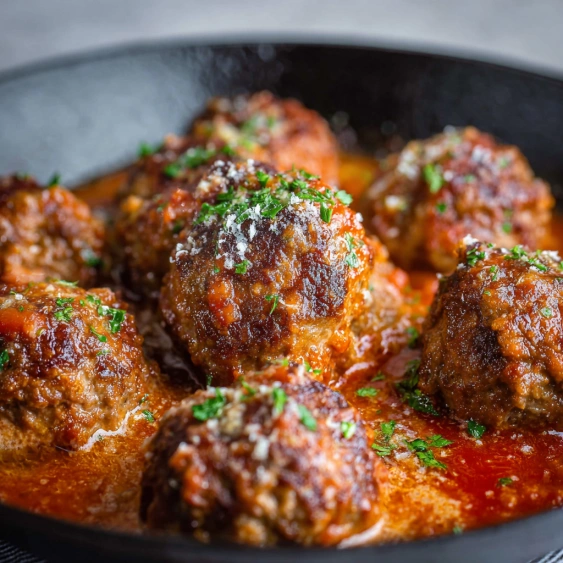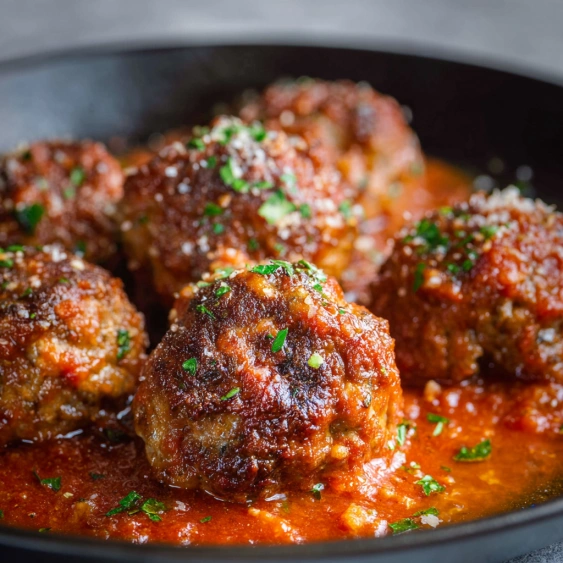 Pin it
Pin it
This authentic Italian beef meatball recipe transforms simple ingredients into tender, juicy meatballs simmered in rich tomato sauce. The slow cooking process infuses the sauce with meaty flavor while ensuring the meatballs remain fork-tender and incredibly satisfying.
My grandmother taught me this recipe when I was just twelve years old. Standing beside her in the kitchen, watching her hands delicately form each meatball, I learned the patience required for true Italian cooking. Now my own children gather around to help, just as I once did.
Ingredients
- White bread cubes: Creates the perfect tender texture in authentic meatballs
- Freshly grated Romano cheese: Provides sharp saltiness that elevates the flavor
- 85% lean ground beef: Offers the ideal balance between flavor and juiciness
- Fresh garlic and parsley: Infuse the meatballs with classic Italian aromatics
- Homemade marinara sauce: Made with both crushed and whole peeled tomatoes creates depth
Step-by-Step Instructions
- Prepare the bread:
- Cut white bread into cubes, removing crusts first. Soak the bread in water until completely saturated, then mash into a smooth paste. This panade is the secret to tender, juicy meatballs.
- Create the flavor base:
- Beat eggs in a large bowl, then add freshly chopped parsley, minced garlic, grated Romano cheese, salt and pepper. The cheese adds both flavor and helps bind the mixture together.
- Mix with meat:
- Add the soaked bread paste and ground beef to the flavor base. Mix gently with your hands until just combined. Overmixing will make the meatballs tough, so use a light touch.
- Form the meatballs:
- Shape mixture into 2.5-inch rounds using gentle pressure. Roll each between your palms until smooth but avoid compressing the meat too much. You should get approximately 16 large meatballs.
- Fry for flavor:
- Heat oil in a large skillet until rippling hot. Place meatballs carefully in the pan without overcrowding. Let them develop a dark crust before turning. This crucial step creates deep flavor through caramelization.
- Simmer in sauce:
- Transfer browned meatballs to homemade marinara sauce. Simmer with lid slightly ajar for at least two hours. This long, slow cooking infuses the sauce with meaty flavor while making the meatballs incredibly tender.
 Pin it
Pin it
The Romano cheese in this recipe is non-negotiable for me. Once I tried substituting Parmesan because it was all I had on hand, and while still good, the distinctive sharp tang that Romano provides was noticeably absent. My grandfather actually refused seconds that night—a clear sign something was amiss in our family's sacred meatball recipe!
The Secret Behind Tender Meatballs
The panade technique—soaking bread in water before mixing it with meat—is what separates exceptional meatballs from mediocre ones. This mixture adds moisture that remains throughout cooking, preventing the proteins in the meat from binding too tightly and becoming tough. This technique dates back generations in Italian cooking and works better than breadcrumbs because it distributes moisture evenly throughout each meatball.
 Pin it
Pin it
Make-Ahead and Storage Options
These meatballs actually improve with time as the flavors meld together. Make them a day ahead for even better results. Refrigerate leftovers in their sauce for up to four days. For longer storage, freeze cooled meatballs with sauce in airtight containers for up to three months. Thaw overnight in the refrigerator and reheat gently on the stovetop until warmed through.
Serving Suggestions
While traditionally served over spaghetti, these versatile meatballs shine in many presentations. Try them on crusty Italian bread for epic meatball subs, served alone as an appetizer with toothpicks, or alongside creamy polenta for a comforting dinner. For a lighter option, serve with roasted vegetables instead of pasta. However you choose to serve them, make sure to have extra grated Romano and fresh basil for garnish.
Cultural Significance
In Italian households, meatballs represent more than just food—they embody family tradition and love. Unlike the American tendency to pair meatballs with spaghetti, authentic Italian meatballs are traditionally served as their own course after pasta. This recipe honors the traditional method of slowly simmering meatballs in sauce, allowing the flavors to develop fully and creating a memorable meal that brings people together.
Frequently Asked Questions
- → Can I bake these meatballs instead of frying them?
Yes! Preheat your oven to 350°F, place the meatballs on a foil-lined baking sheet greased with cooking spray, and bake for approximately 30 minutes. Then continue by simmering them in the sauce.
- → Why do you soak the bread in water before adding it to the meat mixture?
Soaking the bread creates a panade (bread paste) that helps keep the meatballs tender and juicy. It prevents them from becoming tough and dry during cooking.
- → How long should I simmer the meatballs in sauce?
Simmer the meatballs in sauce for at least two hours. This extended cooking time allows the meatballs to impart flavor to the sauce while becoming more tender and juicy themselves.
- → Can I freeze these meatballs?
Absolutely! These meatballs freeze beautifully. You can freeze them either cooked in the sauce or after browning but before simmering. They'll keep well in the freezer for up to 3 months.
- → What can I serve with these meatballs?
These meatballs are traditionally served with pasta like spaghetti or rigatoni. They also make excellent meatball subs when placed in Italian bread rolls with extra sauce and melted cheese on top.
- → Why is it important to brown the meatballs before adding them to the sauce?
Browning creates a flavorful crust through the Maillard reaction, adding depth and richness to both the meatballs and the sauce. It also helps the meatballs hold their shape during the long simmering process.
